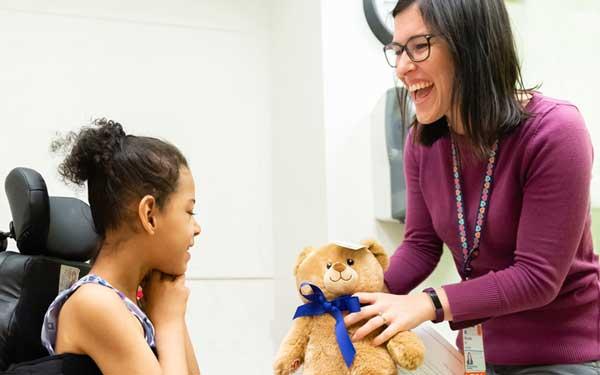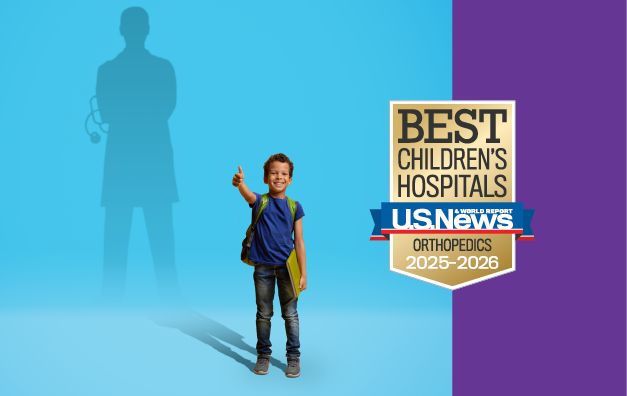Kyphosis in Children & Teens
Make an Appointment
All spines are meant to curve. But if your child’s back curves too much and starts to cause pain, you may need to talk to a spine specialist. When kids have a “hunchbacked” or “rounded” appearance at the top of their spine, it’s called kyphosis.
No one wants to see their child in pain, and if left untreated, kyphosis can also cause problems like trouble breathing. That's why it's so important to see a spine specialist, like the ones at UVA Health Children's, before symptoms become severe.
Kyphosis, like scoliosis and other back curve abnormalities, can range from very mild to severe. Very mild cases often only need a few lifestyle changes to fix. Other times your child may benefit from a back brace or spinal surgery. By visiting a center like UVA Health Children's, you'll be able to see specialists who can help with every type of intervention in one location.
Diagnosing & Treating Kyphosis at UVA Health Children’s
At UVA Health Children’s, you’ll find nationally ranked orthopedic care at the best Children’s hospital in Virginia. We see many kids with back issues every year. We offer a wide range of diagnostic and treatment options.
Diagnosing Kyphosis
Kyphosis can usually be diagnosed based on appearance. But to actually diagnose the type of kyphosis, your provider will most likely also need X-rays.
At UVA Health Children's, we have pediatric-specific imaging. We work hard to make sure we use the minimum amount of radiation while still getting the image quality necessary for diagnosis. While it's easy to diagnose kyphosis based on appearance, understanding what caused the kyphosis helps us shape your child's treatment plan.
Appearance:
- Rounded back, may appear as a hump
- Head always bent forward
- Excessively rounded shoulders
Sometimes, if severe, the spine curve may cause other problems. Kyphosis symptoms include:
- Back pain
- Difficulty breathing
- Fatigue
Early Diagnosis
The earlier kyphosis is diagnosed, the more successful treatment options tend to be. If you or your child is experiencing back pain and a hunched posture, you should see an orthopedist. Our experienced orthopedists can help diagnosis kyphosis early and work on a treatment plan with your family.
Kyphosis Types
There are several types of kyphosis, depending on what the underlying cause is. Knowing the type of kyphosis can help with treatment.
Congenital Kyphosis
In very young children, it’s most likely they were born with this spinal difference. This is called congenital kyphosis (CK).
While congenital kyphosis may be diagnosed at birth, sometimes it isn’t diagnosed until later. Usually when your child begins to walk, the rounded spine will be easy to notice.
CK is caused by part of the spine not forming completely.
If there are no other symptoms, you and your provider may decide to take a wait and see approach. But if it’s causing pain or preventing your child from moving easily, then spinal surgery may be the best option.
Postural Kyphosis
In teenagers, back rounding is usually caused by bad posture. This is usually seen during the growth spurt because the muscles are relatively weak or deconditioned for the child’s new taller and larger body.
This is the most common form of kyphosis.
Postural kyphosis is best treated with physical therapy. It can also be completely reversed.
Scheuermann’s Kyphosis
Between the ages of 8 and 15, children grow rapidly. For most kids, the front and back of their spine grow at the same rate. But for kids with Scheuermann’s disease, their backbones become wedge-shaped, creating a stoop.
Though structural, the symptoms of Scheuermann’s disease are often correctable with physical therapy and possibly bracing.
Kyphosis Treatment Options
Several treatment options are available. What treatment option is best depends on the type and severity of the kyphosis.
Physical Therapy
Virtually all kyphosis treatment plans will include some form of . For those with mild kyphosis, especially postural kyphosis, this may be all that’s needed.
A physical therapist will help by:
- Training your posture
- Stretching
- Strengthening
If your child’s treatment plan includes bracing or surgery, physical therapy will help them tone their muscles to support healing. Our physical therapists can help your child meet their goals over a 4-8 week intensive training.
Bracing
Bracing can prevent a spinal curve from getting worse, but it can’t undo any structural change. Just like with scoliosis, a brace will be fitted to your child by our . Unlike joint braces, spinal braces work best when worn for many hours during the day/night.
Learn several ways to make a brace more comfortable
Spinal Surgery
Spinal fusion surgery for kyphosis is very rare. Bracing and physical therapy help most people. If your provider has determined that surgery is needed, we’ll talk you through the options and what recovery will look like.
Spinal fusion joins two or more vertebrae (back bones) together. This corrects the curve. This solution is permanent, since it involves helping bones grow together.
Recovering from spinal surgery takes anywhere between 6 months to a year. During this period, your child will be able to enjoy many of their normal activities, including school, hanging out with friends, or participating in clubs. They will not be able to do some physical activities, like gym class or sports. But after the bones are completely fused, many kids are able to resume sports, even contact sports. This is something you and your surgeon can discuss.

Nervous About Surgery?
Our child life specialists are experienced at helping kids and their families talk through surgery and hospital stays. They can also help connect you with the resources to keep up with school work or ideas for accommodations that may be helpful.
Kyphosis FAQ
Who’s at risk for kyphosis?
Kyphosis can occur in anyone. But there are some risk factors that make the condition more likely. These include:
- Having a family member with the condition
- Marfan syndrome
- Ehlers-Danlos syndrome
- Spina Bifida
- Cerebral Palsy
- Muscular Dystrophy
- Prader-Willi syndrome
- Osteogenesis Imperfecta (brittle bone syndrome)
- Diabetes
- Spinal fracture
- Spinal infections
- Spinal tumors
Can I prevent kyphosis?
Not all cases of kyphosis can be prevented. Just like scoliosis, this spinal curvature can happen in anyone.
But postural kyphosis can usually be prevented.
- Make sure backpacks are sturdy and supportive
- Exercise to create a strong core and back
- Work on good posture
Find a Related Provider

Nationally Ranked Pediatric Orthopedics
At UVA Health Children's, our orthopedic department is nationally recognized. U.S. News & World Report named us as one of the 50 best pediatric orthopedic programs in the country. We see many children every year for orthopedic issues, including spinal problems like kyphosis.
Learn More About Our Rankings